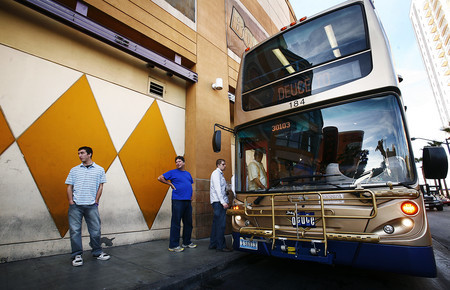HOV lanes on ramps really do serve a purpose, officials insist

Ever since the lanes designated for high-occupancy vehicles were placed on U.S. 95, readers have complained about whether they are needed, wondered whether they help with traffic flow and questioned whether they are even enforced. The Nevada Department of Transportation insists these lanes are effective.
Here’s the most recent beef, compliments of Cherie: On several entrance ramps there are inexplicable HOV lane that abruptly meld into normal driving lanes without warning. Because there is no way for entrance ramp HOV lanes to merge into HOV lanes on the expressway, it was stupid to draw them. Are these HOV lanes on the ramps going to be removed?
Cherie isn’t the first person to call them stupid, trust me. According to the Nevada Department of Transportation, those lanes on the entrance ramps serve a purpose even though you still need to make your way across regular lanes on the highway to reach the high-occupancy vehicle area.
Because vehicles carrying two or more people do not have to stop at the ramp meters, it expedites the flow onto the freeway. So, no, there are no plans to remove those designated lanes on the ramps.
Myth or no myth, Dahn wants to know: Is it true the new bus station cannot accommodate the Deuce on certain routes because they cannot go under viaducts? If so, which routes are affected?
First off, all of the Regional Transportation Commission’s bus terminals can handle the double-deck buses. The only obstacle for the Deuce is the Charleston underpass. You know, the one that fills with floodwater during any substantial storm? That prevents the bus from running along Charleston Boulevard near downtown.
The Deuce primarily runs along the Strip, but routes were extended because of its popularity. That is why you will see the double-decker chugging along busier thoroughfares such as Sahara Avenue and Rainbow Boulevard.
Here’s another bus-related question: I encountered one of the new ACE buses stopped dead at a bus stop on Rancho Drive north of Bonanza this week. No passengers appeared to be boarding or leaving the bus. Are those buses up and running?
Drivers of these sleek new buses are in training and the Regional Transportation Agency is also testing the vehicles. You probably will see more and more of these vehicles around town in the next few weeks. These buses won’t be in full service until mid-March, when they’ll ferry passengers around downtown and along the Strip. However, passengers might get a sneak peak toward the end of January when the ACE bus is tested along the MAX bus line, which stretches from the downtown transportation center toward Nellis Air Force Base. The ACE will allow passengers on that Las Vegas Boulevard route.
Jay is curious about the transportation agency disabling its freeway cameras after a recent accident: I received a text message from the RTC that there was a crash on Interstate 15. I decided to look at how backed up traffic was using the RTC cameras on their Web site. The page said: “Cameras have been disabled at the request of law enforcement.” Why would they do that?
That happens infrequently but is occasionally done to protect possible victims of the accident and their families, according to Tracy Bower of the transportation commission. If the accident is severe and involves fatalities or serious injuries, authorities ask that the cameras in the immediate area be deactivated for fear a family member might sign on and recognize the vehicle. They also do this to protect the privacy of the injured if they can be seen on camera.
If you have a question, tip or tirade, call Adrienne Packer at (702) 387-2904, or send an e-mail to roadwarrior@ reviewjournal.com. Include your phone number.